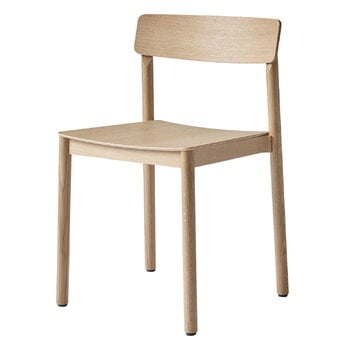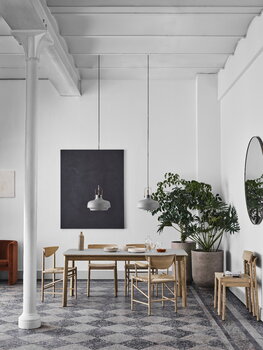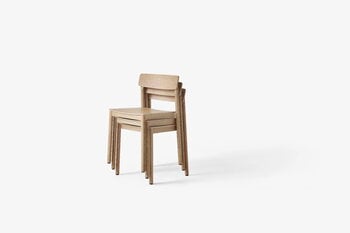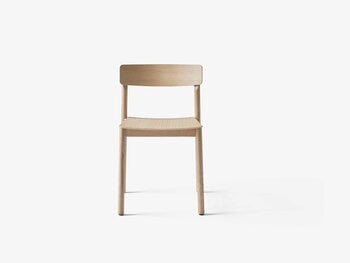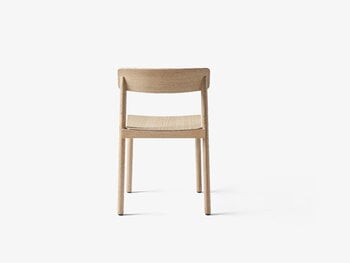&Tradition's Betty TK2 is an oak chair designed by Jakob Thau and Sami Kallio, named after the Betty Nansen Theatre in Copenhagen. The beautiful living wood surface gives the Betty chair a natural feel. Thanks to its solid, light and stackable construction, the multifunctional Betty chairs are ideal for the dining table and will also find a place in other rooms of the home.
Betty TK2 chair, oak
&Tradition
Description
&Tradition's Betty TK2 is an oak chair designed by Jakob Thau and Sami Kallio, named after the Betty Nansen Theatre in Copenhagen. The beautiful living wood surface gives the Betty chair a natural feel. Thanks to its solid, light and stackable construction, the multifunctional Betty chairs are ideal for the dining table and will also find a place in other rooms of the home.
Product details (9)
- Colour
- Lacquered oak
- Width
- 51 cm
- Depth
- 48 cm
- Height
- 77 cm
- Seat depth
- 42 cm
- Seat height
- 47 cm
- Material
- Lacquered solid oak, lacquered oak veneer
- Weight
- 4 kg
- Notes
- Stackable: max 8 chairs. Felt gliders installed as standard.
- Product ID
Reviews (2)
5
Based on 2 reviews
-
C
cristina m
Paris, France
Très bien !
434 days ago
-
L
Laura L
Mynaemaeki, Finland
Kaunis ja ajaton tuote. Itselleni istuinkorkeus melko korkea, mutta tämä on tämän päivän standardikorkeus kaikissa tuoleissa. Puun viimeistely ei esim. jalkaosissa ole täydellistä mutta hinta-laatusuhteessa hyvä
436 days ago
Sustainability
The Product Sustainability Framework, our criteria of sustainable design, helps you find the most sustainable products in our selection. Read below which sustainability criteria this product has met.
Working conditions & labour 8/9
-
Equal opportunities for all employees
-
Commitment to UN Global Compact, fair compensation for all employees
-
Corporate responsibility requirements defined and communicated for suppliers
-
Systematic work for improved inclusion and well-being in the workplace
-
Transparent supply chain
-
Suppliers' compliance to a code of conduct ensured
-
Direct suppliers audited and certified
-
Compliance to the UN Guiding Principles on Business and Human Rights ensured in the supply chain
-
Support for community involvement in the supply chain
Eco-friendly production 6/9
-
Fair and resource-wise water-use in production
-
No incineration or landfilling of returned items
-
No use of endangered species as materials
-
No direct environmental emissions or waste (excl. GHGs) from production
-
Material-efficient and ecological packaging
-
No potentially harmful chemicals used in own production
-
The sustainability of direct suppliers' production is addressed and monitored
-
Production and material sourcing that respect biodiversity, animal rights, and natural ecosystems
-
Positive impact on nature’s well-being through operations that regenerate natural ecosystems
Climate impact 5/8
-
Company's direct greenhouse gas emissions identified and commitment to reduction
-
Product's carbon impact identified and commitment to reduction
-
Guidance on energy- and eco-efficient use of the product
-
Contribution to climate initiatives beyond the brand’s direct operations
-
100 % renewable energy in own production and operations
-
Low-carbon or compensated transportation
-
Carbon footprint of the product calculated and goals set to reduce it
-
Carbon neutral or carbon negative product
Sustainable materials 5/6
-
Sustainable and long-lasting material choices
-
No harmful or hazardous substances
-
Responsible raw material sourcing and production
-
Materials suited for circularity: monomaterials, recyclable finishings, renewable or recycled contents etc.
-
Ecological materials: natural, biodegradable, recyclable or recycled contents
-
Outstanding materials in terms of innovativeness, responsibility, sustainability and circularity: local production or sourcing, 100 % recycled content, C2C-certification etc.
Circular design 4/5
-
High aesthetic quality promoting long-term use of the product
-
Technically durable product design and material choices
-
Design for enduring life-long quality
-
Design and support for product maintenance, repair and upgradability
-
Innovative circular design solutions: circular service system, resale platform, remanufacturing, collection of used products, etc.
